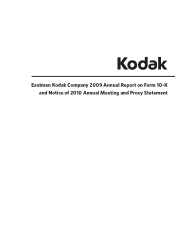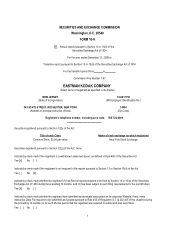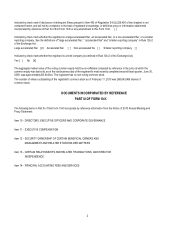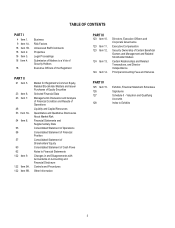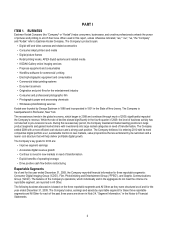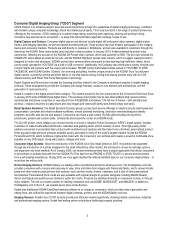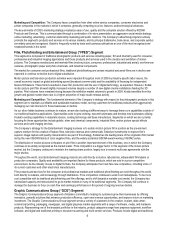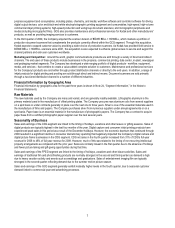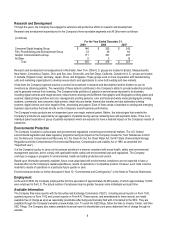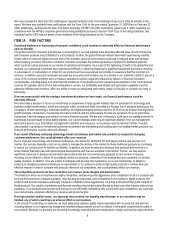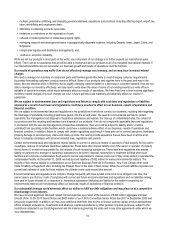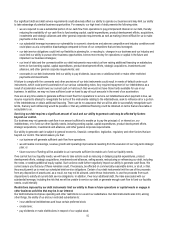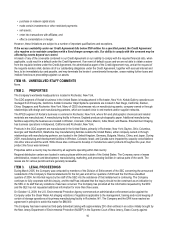Kodak 2009 Annual Report Download - page 9
Download and view the complete annual report
Please find page 9 of the 2009 Kodak annual report below. You can navigate through the pages in the report by either clicking on the pages listed below, or by using the keyword search tool below to find specific information within the annual report. 7
prepress equipment and consumables, including plates, chemistry, and media; workflow software and controller software for driving
digital output devices; color and black-and-white electrophotographic printing equipment and consumables; high-speed, high-volume
commercial inkjet printing systems; high-speed production and workgroup document scanners; and micrographic peripherals and
media (including micrographic films). GCG also provides maintenance and professional services for Kodak and other manufacturers'
products, as well as providing imaging services to customers.
In the third quarter of 2009, the Company acquired the scanner division of BÖWE BELL + HOWELL, which markets a portfolio of
production document scanners that complements the products currently offered within the GCG segment. Through this acquisition,
Kodak expects to expand customer value by providing a wider choice of production scanners. As Kodak has provided field service to
BÖWE BELL + HOWELL scanners since 2001, this acquisition is also expected to enhance global access to service and support for
channel partners and end-user customers worldwide.
Marketing and Competition: Around the world, graphic communications products are sold through a variety of direct and indirect
channels. The end users of these products include businesses in the prepress, commercial printing, data center, in-plant, newspaper
and packaging market segments. The Company has developed a wide-ranging portfolio of digital products - workflow, equipment,
media, and services - that combine to create a value-added complete solution to customers. Maintenance and professional services
for the Company's products are sold either through product distribution channels or directly to the end users. In addition, a range of
inkjet products for digital printing and proofing are sold through direct and indirect means. Document scanners are sold primarily
through a two-tiered distribution channel to a number of different industries.
Financial Information by Geographic Area
Financial information by geographic area for the past three years is shown in Note 24, “Segment Information,” in the Notes to
Financial Statements.
Raw Materials
The raw materials used by the Company are many and varied, and are generally readily available. Lithographic aluminum is the
primary material used in the manufacture of offset printing plates. The Company procures raw aluminum coils from several suppliers
on a spot basis or under contracts generally in place over the next one to three years. Silver is one of the essential materials used in
the manufacture of films and papers. The Company purchases silver from numerous suppliers under annual agreements or on a
spot basis. Paper base is an essential material in the manufacture of photographic papers. The Company has a contract to acquire
paper base from a certified photographic paper supplier over the next several years.
Seasonality of Business
Sales and earnings of the CDG segment are linked to the timing of holidays, vacations and other leisure or gifting seasons. Sales of
digital products are typically highest in the last four months of the year. Digital capture and consumer inkjet printing products have
experienced peak sales in this period as a result of the December holidays. However, the economic downturn that continued through
2009 resulted in a significant decline in consumer discretionary spending that negatively impacted the Company’s digital camera and
digital picture frame businesses in the CDG segment. CDG net sales in the fourth quarter increased from 31% of CDG’s full-year
revenue for 2008 to 46% of full-year revenue for 2009. However, much of this was related to the timing of non-recurring intellectual
property arrangements as compared with the prior year. Sales are normally lowest in the first quarter due to the absence of holidays
and fewer picture-taking and gift-giving opportunities during that time.
Sales and earnings of the FPEG segment are linked to the timing of holidays, vacations and other leisure activities. Sales and
earnings of traditional film and photofinishing products are normally strongest in the second and third quarters as demand is high
due to heavy vacation activity and events such as weddings and graduations. Sales of entertainment imaging film are typically
strongest in the second quarter reflecting demand due to the summer motion picture season.
Sales and earnings of the GCG segment generally exhibit modestly higher levels in the fourth quarter, due to seasonal customer
demand linked to commercial year-end advertising processes.

